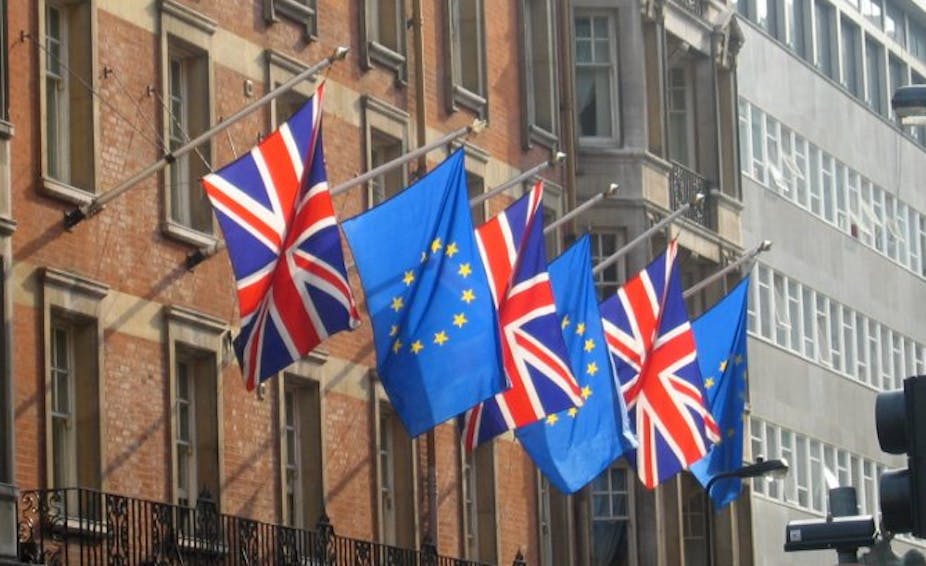Whichever way you look at it, the UK is going through a stormy period in its relationship with the European Union. David Cameron has promised to renegotiate the UK’s relations with the EU and to hold a referendum should he get re-elected and there are commentators and politicians who clearly favour the withdrawal of the UK. But for those of us working in the millions of jobs linked to our near neighbours on the continent, the thought should be a deeply worrying one.
Those in favour of withdrawal typically cite the overbearing control Brussels has on UK policy matters. They take an optimistic view on the feasibility of the UK re-negotiating its relationship with the EU as well as the complex web of trade agreements that the EU, and hence the UK, currently has with trading partners around the world.
Those against point to the economic interdependence between the UK and the EU, manifested in part by the extent of bilateral trade, and are much less optimistic about re-negotiation. They express concern about the UK’s consequent absence from EU decision making, and point to the net benefits arising from EU-UK free movement of labour. A large chunk of British business is sympathetic to these ideas – with some crucial caveats – and it is to their concerns that Labour leader Ed Miliband has sought to appeal this week. Positions on this are clearly as much (if not more) political as they are economic.
Measuring interdependence
It is important to understand how the UK is linked not just to the EU but also the rest of the world. If we just look at the trade numbers then we see that the share of the EU in the UK’s trade is close to 50%. This is true whether you look at import or exports, and is also true if you take just trade in goods, or trade in goods and services.
The bottom line is that the EU is an important destination for UK exports and an important supplier of imports. This is already well known, does little to persuade the naysayers, and is self-evidently important to those with a more positive view of the EU. But there is more to the tale.

That 50% number is based on gross trade figures. Gross trade exports capture the value of all that is exported by the UK, but it will include items and services which comprise some input from abroad – say French onions in a Gloucester-made, tinned onion soup. There might be £30 worth of these in every £100 of UK exports, and in turn there may be some UK input to the intermediates from abroad – say British fertiliser to grow the French onions. That might equate to £5 and would mean the value of all UK economic activity embodied in its exports, often referred to as “value-added exports”, would be £75 in every £100. A classic example, frequently cited, relates to Chinese exports of the iPhone. China is a major iPhone exporter, yet Chinese value added (economic activity) embodied in the iPhone has been calculated to be no more than around 4%.
Recent data improvements allow us to capture such flows. When you look at the value-added trade figures for 2011, once again the share of the EU in the UK’s exports remains around 50%. The top five destination countries for the UK are, in order of importance:
- The USA
- Germany
- The Netherlands
- Ireland
- France
Between them these countries account for nearly 40% of the UK’s exports. However, some of these exports are UK intermediates which are then used by the destination countries in turn in their exports. The top five countries that use the UK’s goods in their exports are, again in order of importance, and with their shares in brackets:
- Germany (12%)
- Ireland (11.9%)
- Netherlands (10.2%)
- Luxembourg (9.1%)
- Belgium (5.6%).
In the top ten countries there are only two non-EU countries – the US (4.8%) and China (3.3%). This suggests very strongly that the UK is integrated with EU countries quite differently to how it is integrated with non-EU countries.
Just the job(s)
This can be seen by looking at the employment predicated on the UK’s exports to different destinations; and then also UK employment embodied in our partner’s exports. So, instead of looking at the trade flows, we are looking at the jobs directly and indirectly involved in the UK’s trade with its partner countries.
The table below provides a snapshot of the UK’s export jobs. The first two columns show that of all these export jobs, just over 45%, or 3.78 million jobs, arose from UK exports to the EU and 54.5% from exports to non-EU countries.
The table also show the most important EU and non-EU destinations when considering the UK’s export jobs. It is worth noting that the share of the EU in the UK’s export jobs has declined from 50% in 1995, largely due to the rapid growth in emerging economies like China and India.

As with the value-added trade numbers above, we can also calculate the number of UK jobs associated with the partner countries’ exporting activities. This can be seen in the third and fourth columns, where once again we can distinguish between the EU, and non-EU countries.
This reveals that in 2011 there were 1.46 million UK jobs arising from the exports of the EU countries, while only half that amount (0.7 million jobs) were associated with the exports of non-EU countries.
So there is a substantial structural difference between the nature of the economic integration of the UK with the EU and with the rest of the world, which can then be seen from the last two columns of the table. For each destination these give the share of the UK’s export jobs to that destination which derive from each partner country’s exports (we call these “UK-partner export jobs”). So, if you look at the EU total, we see that in 2011 of the 3.8 million jobs arising from the UK’s exports to the EU, 1.46 million, or 38.7%, derive in turn from the EU’s exports.
These are UK jobs providing EU countries with goods and services that they use to produce their own exports. This level of integration varies across the EU, but in each case is significantly higher than for non-EU countries.
What is then striking is the comparison between 1995 and 2011. This reveals that the UK’s engagement in EU supply chains has risen significantly over time. In 1995, 27.3% of the jobs in the exports of the UK to the EU, derived from the EU’s exports, and this had risen to 38.7% by 2011. Once again we see a rise in such integration with regard to each of the EU countries in the table.
Service updates
In the second table, below, we list the ten most important sectors (out of 35) in terms of the UK’s export jobs to the EU. The first two columns give the number of jobs associated with the UK’s exports of these sectors to both the EU and non-EU countries.
So there were 826,300 jobs directly associated with the UK’s exports of business services to the EU. We see from the last row that UK export jobs are fairly highly concentrated – these ten sectors account for nearly 70% of the UK’s EU export jobs. We also seethe importance of service sector jobs – six of the ten sectors are service sectors.
And in the final two columns we again see the much greater integration of the UK with the EU than with non-EU countries. This much higher linkage between the UK and the EU, in comparison to the UK and non-EU countries is seen in all sectors.

Keep your friends close
The past 15 years have seen a structural change in the UK’s exports and a growing importance of services. Non-EU countries are expanding as a destination for UK exports, and therefore also UK export jobs; and this is almost certainly driven by the faster growth of these countries.
But this data suggests that UK employment is very closely tied to EU partners via value-chains in a way that non-EU export jobs simply are not. This is no doubt in part driven by the simple fact that EU is so close, but it is also hard to believe that this is not driven by regulatory commonalities in the single market. These interwoven relationships along the value chain are in stark contrast to the kind of “ship and forget” trade that appears more characteristic of non-EU trade.
All this means that any policy which may negatively affect EU-related jobs needs serious justification, and that justification should not just be political. UK export jobs may be vulnerable to changes in the terms of the relationship, economic and institutional, between the UK and the EU.
Uncertainty around the UK’s position in the EU, as well as any subsequent policy changes, can easily damage value-chain trade and the jobs associated with that trade. Leaving the single market may threaten a substantial number of UK jobs and not just in the manufacturing heartlands vulnerable to the rise of Asia but also in the services sectors where growth in employment has been the greatest over the past two decades. The political rush to consider that stark choice of leaving the EU must not sidestep the connectedness that marks out our trading ties – and which helps to support close to 4 million jobs.
This piece was co-authored with Bridget Azubuike from Interanalysis Ltd at the University of Sussex

